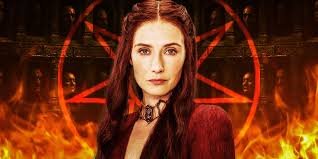
Amid the desolate grandeur of Westeros, where bloodlines dissolve into ruin and ambitions writhe like serpents, one figure emerges cloaked in crimson and cloaked in deeper riddles—Melisandre, the Red Woman. Neither mere prophet nor mere charlatan, she is an enigma forged of fire and fate. She doesn’t merely whisper omens; she conjures them from smoke and ember, weaving them into the very sinews of the Game of Thrones. Herein lies a meticulous unravelling of her genesis, mysticism, entanglements, and tremors left in her wake—a dissection not of surface but of marrow.
The Genesis Veiled in Cinders: Who Walks Behind the Red Veil?
Spawned from the shadow-swathed city of Asshai—far-flung and clinging to the forgotten hem of Essos—Melisandre’s beginnings are saturated in obscurity. Once shackled in servitude, she shed her chains only to enrobe herself in servitude anew—this time to the flame god R’hllor. Her transformation is not merely spiritual; it is alchemical. Unlike mundane adherents, she harbours visceral gifts: glimpses into unseen tomorrows and mastery over ink-black sorcery.
But what truly renders her spectral is the hushed truth of her age. When, in a moment unmoored from vanity, she strips away her ensorceled necklace, the illusion fractures, revealing a timeworn visage centuries removed from the youthful facade. An eternal sentinel garbed in false bloom.
In Fire She Trusts: Faith Carved from Pyres and Premonition
Melisandre’s marrow-deep allegiance to R’hllor consumes her every breath. She is not a devotee; she is a vessel. Believing herself appointed to shepherd the elusive “Prince That Was Promised,” she affixes her divine certitude to Stannis Baratheon. Her counsel becomes a gilded noose, goading him toward grim deeds cloaked in celestial justification.
Her flame-born visions are cryptic riddles, open to fatal misreading. She sees symbols dancing in infernos—phantoms she interprets with unwavering conviction. Yet time and again, her perceived truths curdle into ruin. Her prophetic lens, though potent, is fogged by her dogma, blurring discernment and summoning catastrophe beneath a halo of faith.
Arcane Instruments: Murder in Smoke, Life from Ash
Where most invoke belief, Melisandre channels the unholy. Her dominion over magic does not shimmer; it scars. Her conjuring of a shadow assassin to extinguish Renly Baratheon isn’t a trick—it’s a chilling invocation of death itself, birthed in darkness and intent.
Yet it is not destruction alone that defines her sorcery. In the frost-bitten halls of Castle Black, her hands cradle resurrection. Jon Snow’s lifeless form—betrayed by his kin—is restored by her will, transfiguring doubt into devout hope. It is a resurrection not just of flesh, but of her crumbling faith. This moment recalibrates her belief; Jon becomes her new messianic flamebearer.
Stannis and the Scarlet Mirage: Faith Tangled in Folly
Between Melisandre and Stannis unravels a saga of zealotry and ruin. He leans into her spectral wisdom, his will bending like steel in heat. Through her urgings, he forsakes reason, culminating in the sacrificial immolation of his daughter, Shireen—an act that curdles even the most jaded soul.
Intended as a rite to summon victory, it instead delivers obliteration. His army shatters; his reign extinguishes. Melisandre, now a priestess shrouded in fallibility, flees into exile—her prophecies broken, her purpose fractured.
Redemption Among the Snowdrifts: A Flame Rekindled
After retreating into the cold corridors of Castle Black, Melisandre finds both reckoning and revival. Her part in Jon Snow’s return to life is a salve upon her scorched conscience. Though redemption clings loosely to her name, she walks a penitent path—a scarlet ghost searching for absolution in a land of steel and shadow.
In the final conflagration—the Battle of Winterfell—she resurfaces, a flame-wielding revenant. Her igniting of the Dothraki blades and trench fires injects fire into failing hearts. In her last deed, she becomes the light she always preached. Purpose fulfilled, she sheds her spellbound youth, embraces her ancient truth, and dissolves into the snow, her journey extinguished in silence.
Duality Enfleshed: Between Radiance and Ruin
Melisandre is not a symbol. She is a contradiction incarnate—where light births darkness and salvation cloaks damnation. Her certainties give rise to abominations; her miracles carry the scent of sulfur. She prompts the question: Can righteousness exist when it’s forged in blood and fire?
She is also a rare conduit of feminine dominion in a realm ruled by blades and bloodlines. Her influence emerges not from armies or thrones but from the unseen—the spiritual, the sublime, the terrifying. She commands without screaming. She moves fate without touching it.
Carice van Houten: The Flesh Behind the Flame
In Carice van Houten’s portrayal, Melisandre becomes a paradox made flesh—simultaneously statuesque and serpent-like. There is austerity in her gestures, but within her gaze—a storm. Each word, tempered and deliberate, carries a tremor. Her performance is not just an embodiment; it is a ritual, layering mystique atop mystique until the character pulses with a gravity that is both divine and doomed.
The Imprint Left in Embers
Melisandre’s legacy is not marked by victories or crowns, but by shifts in the axis of the tale. She alters the course of kings and kin alike. Her interventions—resurrecting the dead, felling the living, kindling last chances—etch her influence into the bedrock of Westeros.
She remains an embodiment of spiritual extremism, a mirror to the peril of certainty in uncertain worlds. Her flame may flicker out in the snows beyond Winterfell, but its echoes burn still—ominous, elusive, unforgettable.
Also Read: Golden Dragon Login – Immersive Digital Arcade Realms



